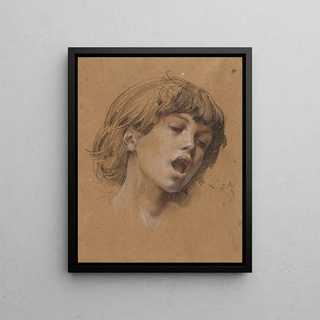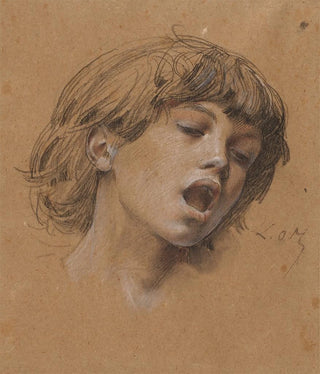Art print | Head of a singing boy in musical study - Luc-Olivier Merson


View from behind

Frame (optional)
In the fascinating world of art, some works manage to capture the very essence of humanity through delicate expressions and nuances of light. The art print Tête d'un garçon chantant en étude musicale - Luc-Olivier Merson is a perfect example. This painting, imbued with poetry, transports us to the heart of an intimate scene where music and emotion intertwine. The artist, with remarkable mastery, succeeds in bringing his subject to life, a young boy whose singing seems to resonate through time. This piece does not merely depict a frozen moment; it invites the viewer to feel the melody emanating from this juvenile face, to immerse themselves in the softness of the moment.
Style and uniqueness of the work
Luc-Olivier Merson's style is distinguished by his ability to merge realism and idealization. In Tête d'un garçon chantant en étude musicale, every detail is carefully crafted, from the delicate features of the face to the reflections of light in the boy's eyes. The color palette chosen by Merson evokes a warm, almost nostalgic atmosphere that envelops the viewer. The way light caresses the young singer's face, creating subtle shadows, demonstrates refined technique and a deep understanding of light effects. This painting is not limited to the image of a singing boy; it is a true study of human emotion, an exploration of passion and vulnerability. The composition, balanced and harmonious, draws the eye and invites prolonged contemplation, making this work a true masterpiece.
The artist and his influence
Luc-Olivier Merson, an emblematic figure of the 19th century, knew how to mark his era with an innovative approach to painting. Raised in an artistic environment, he was influenced by the great masters of classical painting while developing a personal style that is uniquely his own. His ability to depict the human soul with such depth made him a respected and admired painter. Merson often explored themes related to music, poetry, and beauty.

Matte finish

View from behind

Frame (optional)
In the fascinating world of art, some works manage to capture the very essence of humanity through delicate expressions and nuances of light. The art print Tête d'un garçon chantant en étude musicale - Luc-Olivier Merson is a perfect example. This painting, imbued with poetry, transports us to the heart of an intimate scene where music and emotion intertwine. The artist, with remarkable mastery, succeeds in bringing his subject to life, a young boy whose singing seems to resonate through time. This piece does not merely depict a frozen moment; it invites the viewer to feel the melody emanating from this juvenile face, to immerse themselves in the softness of the moment.
Style and uniqueness of the work
Luc-Olivier Merson's style is distinguished by his ability to merge realism and idealization. In Tête d'un garçon chantant en étude musicale, every detail is carefully crafted, from the delicate features of the face to the reflections of light in the boy's eyes. The color palette chosen by Merson evokes a warm, almost nostalgic atmosphere that envelops the viewer. The way light caresses the young singer's face, creating subtle shadows, demonstrates refined technique and a deep understanding of light effects. This painting is not limited to the image of a singing boy; it is a true study of human emotion, an exploration of passion and vulnerability. The composition, balanced and harmonious, draws the eye and invites prolonged contemplation, making this work a true masterpiece.
The artist and his influence
Luc-Olivier Merson, an emblematic figure of the 19th century, knew how to mark his era with an innovative approach to painting. Raised in an artistic environment, he was influenced by the great masters of classical painting while developing a personal style that is uniquely his own. His ability to depict the human soul with such depth made him a respected and admired painter. Merson often explored themes related to music, poetry, and beauty.






